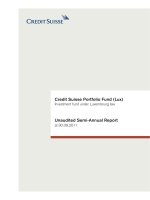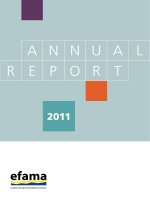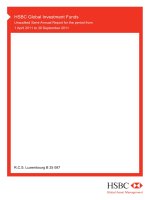ANNUAL REPORT 2011 VIETNAM SECURITIES INVESTMENT FUND potx
Bạn đang xem bản rút gọn của tài liệu. Xem và tải ngay bản đầy đủ của tài liệu tại đây (2.61 MB, 74 trang )
VIETNAM SECURITIES INVESTMENT FUND (VF1)
1
VF1
ANNUAL REPORT 2011
VIETNAM SECURITIES INVESTMENT FUND
VIETNAM SECURITIES INVESTMENT FUND VF1
ANNUAL REPORT 20112
ABBREVIATIONS
HOSE
Hochiminh Stock Exchange
IR
Investor Relations
JSC
Joint Stock Company
NAV
Net Asset Value
Q
Quater
AR
Annual Report
BOR
Board of Representative
CEO
Chief Executive Officer
EPS
Earning per share
HNX
Hanoi Stock Exchange
VIETNAM SECURITIES INVESTMENT FUND (VF1)
3
English name Vietnam Securities Investment Fund
Trading Code VFMVF1
Investment objective VF1 aims to invest to listed and unlisted shares fixed-income securities and other financial instruments to build a balanced
portfolio
Fund type Closed-end public fund
Current chartered capital 1,000,000,000,000 VND
Outstanding fund unit 100,000,000 units
Inception date May 20, 2004
Listing date November 8, 2004
Fund term 10 years
Management Fund VietFund Management (VFM)
Custodian Joint Stock Commercial Bank for foreign trade of Vietnam (Vietcombank)
Management fee 2%NAV/year
Custodian & depositing fees 0,08%NAV/year
Dividend By annual, based on realized return and approved by Annual Meeting of Investors
FUND INFORMATION
ROE
Return on Equity
VFM
VietFund Management
VND
Vietnam Dong
VFA Investment Fund or VFA
Vietnam Active Fund
VF4 Investment Fund or VF4
Vietnam Blue-chips Fund
VF2 Investment Fund or VF2
Vietnam Growth Investment Fund
VF1 Investment Fund or VF1
Vietnam Securities Investment Fund
UPCOM
The Unlisted Public Companies Market
VN-Index/ VNI
Over-the-counter
P/E
Price-Earnings Ratio
ANNUAL REPORT 20114
FINANCIAL HIGHLIGHTS
CONTENT
GENERAL
Abbreviation
Fund information
Financial Highlights
Summary of Vietnam Economy 2011
Letter from the Chairman of the BOR
Letter from CEO of VietFund Management
PERFORMANCE REPORT
NAV Report
Operation Report
Investment Operating
Disbursement - Divestments activities
Operational Results
2
3
4
6
10
11
12
14
15
17
18
20
Note: (*) NAV excludes divident payment
2011 2010 2009 2008 2007 2006 2005 2004
Fund size (VND billion) 1,000 1,000 1,000 1,000 1,000 500 300 300
NAV (VND billion)
1,298.3 2,126.3 2,479.9
1,697.0 3,837.1 1,564.1 381.6 304.5
NAV/unit (VND) 12,983 21,263 24,799 16,970 38,371 31,281 12,718 10,158
NAV 52-week high (VND) 21,891 26,300 29,158 37,569 52,041 33,552 12,850 10,158
NAV 52-week low (VND) 12,848 20,230 15,423 16,313 33,042 12,957 10,121 10,000
Expenses (%) 2.2 2.1 2.15 1.9 2.3 14.0 4.0 1.5
Portfolio turnover (%) 35.7 50.4 63.1 17.9 19.4 45.7 51.5 53.7
Annualized growth (%)
NAV (38.9) (8.2) 46.1
(52.6) 28.1 157.8 27.7 1.6
VN-Index (27.5) (2.0) 56.8 (66.0) 23.3 144.5 28.5 (8.5)
HNX-Index (48.6) (32.1) 60.0 (67.5) 33.2 152.4 (3.8) N/A
Cumulative growth since inception (%)
NAV (*) 29.8 127.6 160.0
81.7 300.7 227.8 29.7 1.6
VN-Index 34.4 85.3 89.1 20.7 254.4 187.4 17.6 (8.5)
HNX-Index (41.3) 14.2 68.2 5.1 223.6 142.9 (3.8) N/A
1 year 2 years 3 years 4 years 5 years 6 years 7 years Since inception (20/05/2004)
Cumulative growth (%)
NAV (38.9) (47.6) (23.5)
(66.2) (17.0) 240.2 326.4 29.8
VN-Index (27.5) (28.9) 11.4 (62.1) (53.2) 14.3 46.9 34.4
HNX-Index (48.6) (65.1) (44.1) (81.8) (75.8) (39.0) (41.3) N/A
Compound annual growth rate (%)
NAV (38.9) (27.6) (8.5)
(23.7) (3.7) 22.6 23.0 3.5
VN-Index
(27.5) (15.7) 3.7
(21.5) (14.1) 2.3 5.6 4.0
HNX-Index
(48.6) (40.9) (17.6)
(34.7) (24.7) (7.9) (7.3) N/A
Note: (*) NAV excludes divident payment
VIETNAM SECURITIES INVESTIMENT FUND (VF1)
5
2011 2010 2009 2008 2007 2006 2005 2004
Fund size (VND billion) 1,000 1,000 1,000 1,000 1,000 500 300 300
NAV (VND billion)
1,298.3 2,126.3 2,479.9
1,697.0 3,837.1 1,564.1 381.6 304.5
NAV/unit (VND) 12,983 21,263 24,799 16,970 38,371 31,281 12,718 10,158
NAV 52-week high (VND) 21,891 26,300 29,158 37,569 52,041 33,552 12,850 10,158
NAV 52-week low (VND) 12,848 20,230 15,423 16,313 33,042 12,957 10,121 10,000
Expenses (%) 2.2 2.1 2.15 1.9 2.3 14.0 4.0 1.5
Portfolio turnover (%) 35.7 50.4 63.1 17.9 19.4 45.7 51.5 53.7
Annualized growth (%)
NAV (38.9) (8.2) 46.1
(52.6) 28.1 157.8 27.7 1.6
VN-Index (27.5) (2.0) 56.8 (66.0) 23.3 144.5 28.5 (8.5)
HNX-Index (48.6) (32.1) 60.0 (67.5) 33.2 152.4 (3.8) N/A
Cumulative growth since inception (%)
NAV (*) 29.8 127.6 160.0
81.7 300.7 227.8 29.7 1.6
VN-Index 34.4 85.3 89.1 20.7 254.4 187.4 17.6 (8.5)
HNX-Index (41.3) 14.2 68.2 5.1 223.6 142.9 (3.8) N/A
1 year 2 years 3 years 4 years 5 years 6 years 7 years Since inception (20/05/2004)
Cumulative growth (%)
NAV (38.9) (47.6) (23.5)
(66.2) (17.0) 240.2 326.4 29.8
VN-Index (27.5) (28.9) 11.4 (62.1) (53.2) 14.3 46.9 34.4
HNX-Index (48.6) (65.1) (44.1) (81.8) (75.8) (39.0) (41.3) N/A
Compound annual growth rate (%)
NAV (38.9) (27.6) (8.5)
(23.7) (3.7) 22.6 23.0 3.5
VN-Index
(27.5) (15.7) 3.7
(21.5) (14.1) 2.3 5.6 4.0
HNX-Index
(48.6) (40.9) (17.6)
(34.7) (24.7) (7.9) (7.3) N/A
BOARD OF REPRESENTATIVES ACTIVITIES
Board of Representatives Members
Board of Representatives Contribution in 2011
Board of Representatives Activities in 2011
VIETFUND MANAGEMENT
Overview
Events and Social activities in 2011
Products - Services
Investor care activities
FINANCIAL STATEMENT
DISCLAMER
30
31
32
33
34
35
36
38
40
44
73
ANNUAL REPORT 20116
A summary of Vietnam Economy 2011
Highlight of Vietnam Economy 2011
Quarterly GDP Value and Growth (2000-2011)
y/y % GDP growth by quarter GDP quarterly
x1000
20
40
60
80
100
120
140
160
180
200
1
2
3
4
5
6
7
8
9
10
%
2000
Q1
2000
Q4
2001
Q3
2002
Q2
2003
Q1
2003
Q4
2006
Q1
2004
Q3
2006
Q4
2008
Q2
2009
Q4
2005
Q2
2007
Q3
2009
Q1
2010
Q3
2011
Q2
Source: HSC, VFM
Export and Trade Deficit (2005-2011)
12.000
10.000
8.000
6.000
4.000
2.000
0
-2.000
-4.000
01 06 11 04
2005
0209
2006
12 0507
2007
10 03
2008
08 01
2009
06 11 04
2010
09
2011
Source: HSC, VFM
Exports Imports Trade deficit
The economy grew by 5.89% in 2011
and encountered many difficulties due to a
long period of overheating. However, it has
achieved encouraging results. Particularly
foreign trade value stood at US$202 billion,
producing trade deficit of US$9.5 billion,
equivalent to 9.86% of export value (target
18%). Remittance reached US$9 billion, a
year-on-year increase of 12%. The balance of
payment is expected to lean to US$3 billion of
surplus compared with US$3 billion of deficit
in 2010 and US$8.8 billion of deficit in 2009.
Vietnam’s economy is now in the toughest time
ever since 1998. Economic indicators, mainly
GDP growth and consumer price index, have
been revised negatively. The Dong has been
depreciated against the Dollar. Additionally,
industrial production index has declined from
July, indicating economic contraction due to
slowing consumption and rising costs.
In 2011, structural weaknesses and
imbalances of the economy emerged, leading
to escalating prices, currency depreciation,
abnormally high interest rates, soaring trade
deficit, decreasing reserves, and illiquidity of
the banking sector.
The economic woes adversely affected the
corporate sector, which encounter slowed
revenue growth and squeezed margins. Listed
companies were expected to post revenue
growth of 30% but delivered net income
growth of only 4.5%, making EPS decline
by approximately 17% in 2011. Especially,
real estate and securities companies may
face higher probability of bankruptcy due to
cash flow problems and manufacturing firms
encounter slowdown in consumption and
rising production costs.
VIETNAM SECURITIES INVESTMENT FUND (VF1)
7
The Causes
Credit Growth 2006-2011
Credit m/m (RHS)
Credit y/y
avg. 5 year credit growth
60
50
40
30
20
10
0
10
8
6
4
2
-
-2
2006
12
2008
12
2011
12
2007
12
2009
12
2012
12
2010
12
Source: Dragon Capital
avg. 5 year M2 growth
M2 m/m (RHS)
M2 y/y
8
7
6
5
4
3
2
1
0
-1
-2
50
40
30
20
10
0
2006
12
2008
12
2011
12
2007
12
2009
12
2012
12
2010
12
Source: Dragon Capital
ICOR —Private Sector and SOEs
12
10
8
6
4
2
2001
2004
2007 2010
Source: HSC
SOE’s ICOR Private Sector’s ICOR
Money Supply 2006-2011
The economy faced cyclical problems in 2009-
2011 due to the following main causes.
■ The global economy was in recession. While
not having truly recovered from the 2008 crisis,
the global economy has to cope with brutal
effects of the European debt catastrophe, the
earthquake in Japan, and political unrests in
world hot spots.
■ Growth has heavily depended on credit and
investment while efficiency is low.
■ The regulatory policy for the economy has not
been very effective and still obtains generalized
solutions.
■ Credit and money supply (M2) increased at
a fast pace since 2006. Annualized credit
growth and money supply were 35% and
25% respectively in 2006-2010. Easy credit
led to widespread inefficient investment
with total investment averaging up to 42%/
year in three years before 2011. Economic
growth deepened its reliance on investment,
especially public investment. Accordingly,
state-owned enterprises accounted for 40%-
50% of total investment but contributed only
15%-20% to GDP and employed only 5% on
total labor.
■ In the first six months, public policies focused
on growth, ignoring escalating economic woes.
This led to inconsistent policy administration
and deteriorated market confidence and
business stability.
The government has fully identified and
acknowledged the causes, and implemented
strategic changes to address the structural issues.
They have developed a comprehensive and
consistent set of measures to fix the problems, a
significant change in policy administration.
ANNUAL REPORT 20118
Solutions for and Prospects of Vietnam’s Economy
No. Items Plan 2012 Actual 2011(%)
1. GDP growth 6 5.9
2. Export growth 13 33
3. Trade deficit (% export) 11-12 10
4. Budget deficit (% GDP) 4.8 4.9
5. Total investment(% GDP) 33.5 34.6
6. Inflation Under 10 18.53
7. Credit growth 15-17 12
8. Money supply growth Under 15 10.2
Source: Resolution 11/2011/QH13 on Social and Economic
Development 2012 by the National Assembly on 9/11/2011.
■ Fiscal policy has been modified to control fiscal deficit and
rein in public investment.
■ Formal estimates show that the economy could make
positive progress in 2012, which will contribute to the long-
term prospect. The structural problems of the economy have
been addressed and solutions have been sought, paving the
way for economic stability and corporate business recovery
and growth.
■ Consistent implementation of economic policies produced
positive results in the fourth quarter of the year, seeing
through decelerating consumer price index, controlled
foreign exchange market, and interest rates.
■ Economic growth targets for 2011-2015 have been revised.
The main focuses of this period are to control inflation,
stabilize the economy, maintain moderate economic
growth, and restructure the economy. GDP growth for 2012
is targeted at a modest level of 6% and consumer price
index at 10%.
■ Restructuring the economy will focus on public investment,
state-owned enterprises, and the banking sector.
■ The consistent implementation of monetary tightening
policy since February has delivered positive results and has
been proved appropriate for the long-term stabilization.
■ Banking reform has been in focus and rigorously
implemented. Accordingly, three small banks were merged
in December and the restructuring process will be pushed
in 2012.
VIETNAM SECURITIES INVESTMENT FUND (VF1)
9
Stock Market and a New Phase
Source: VFM
Total HOSE HNX
Index level 30/12/2011 351.6 58.7
Index level 31/12/2011 481.4 112.64
Change -27.5% -48.6%
Number of share 672 289 383
Market capitalization (mil.VND) 537,505
453,784
83,721
Market capitalization (mil.USD) 25,552 21,572 3,980
P/E 6.81 6.89 6.40
P/B 1.08 1.16 0.68
ROA (%) 9.00 9.29 7.50
ROE (%) 18.13 18.31 17.19
EPS 3,086 3,139 2,811
■ At the end of 2011, the Vietnam stock market had very low
valuation compared with regional peers in terms of relative
valuation indicators P/E and P/B.
■ However, with positive changes going on, the corporate
sector is expected to improve performance.
■ The stock market is expected to recover in 2012, following
economic stabilization, recovery of credit supply from the
banking sector, and the shift in economic growth model.
■ The deteriorating economic fundamentals of Vietnam have
damaged the stock markets with VN-Index falling by 27%
and HNX-Index losing 48%.
■ Additionally, the economic woes undermined financial
performance of the corporate sector in 2011. In combination
with economic problems, poor performance of listed
companies brings market valuations down and deteriorates
investors confidence.
■ With limited fresh cash flows to the market and concerns
over the economic problems, investors have lost confidence
in the market.
ANNUAL REPORT 201110
Vietnam stock market witnessed a sharp plunge in 2011 due to economic uncertainty
and global economic recession. High inflation, over government spending, increased
trade deficit and below-target GDP growth, resulted from the monetary tightening
policy, has created a deeper negative impact on both Indices in the Vietnam stock
market.
Being affected by prolonged negative movements, VF1 performance was not an
exception although we have done all our best to maintain the fund value. To prepare
for the fund maturing in the next coming time, our strategies have been carefully
deliberated under the supervision of the Investment Committee in order to issue the
most appropriate policies at each stage of the market by streamlining the portfolio and
increasing number of high liquidity stocks.
The market of 2012 is forecasted to remain difficult due to the loss of confidence
and trading hesitation from the investors. However, the government has committed
to restructuring the capital market, reforming the banking system, and adjusting the
trading structure. In addition, Circular 183 regulated open-end fund operation has
just issued last year as a foundation and motivation for the market in the next coming
years, as well as a favorable condition for the fund to convert from closed-end fund
to open-end fund. We hope stock market will attain some positive signals to meet
investors’ expectation.
Sincerely thanks and wish you all a very happy prosperous year.
Truly yours,
Luu Duc Khanh
Chairman of the Board of Representatives
Dear valued investors,
“Our strategies
have been carefully
deliberated under
the supervision of the
Investment Committee
in order to issue the most
appropriate policies at
each stage of the market
by streamlining the
portfolio and increasing
number of high liquidity
stocks.”
Letter from the Chairman of the Board of Representative
VIETNAM SECURITIES INVESTMENT FUND (VF1)
11
Dear Investors,
“VFM is ready to establish
new open-end funds for
investors’ consideration.
The transformation
of current closed-end
funds into the open-end
fund will denitely help
solving many diculties
for both investors and
the fund management
companies.”
Vietnam stock market last year witnessed the most difficult time during the five recent
years. The local turmoil has originated from the global economic uncertainties and
European debt crisis which negatively influenced on Vietnam economy. The stock
market still followed the downtrend, trading transaction and liquidity plunge sharply,
creating difficulties to investment funds in Vietnam.
VFM’s funds have not met the plan mainly due to the fall of VN-Index. VFM follows
the value-base investment strategy, so that we do not follow the buy/sell policy that
is led by the market – mover stocks. Our goal is to maximize the Fund’s value growth
as the market recovers.
Entering 2012, although the market is forecasted to remain difficult, positive actions
from the authorities including commitments to stabilize macro economy, restructure
the stock market, especially that the newly issued regulation on the open-end fund
operation have opened new opportunities to the market and investors. The regulation
is a strong foundation to stimulate foreign and local funds to operate in a more
sufficient matter.
With the issuance of Circulation 183, VFM is ready to establish new open-end funds
for investors’ consideration. The transformation of current closed-end funds into the
open-end fund will definitely help solving many difficulties for both investors and the
fund management companies. We will present clear explanations on the pros and
cons of the transformation for shareholders to vote as per benefits of investors and
expectation of the majority. This transformation has not yet happened in Vietnam
stock market; therefore, dealing with the legal processes and converting portfolio to
more liquid stocks are our greatest challenges.
We hope that the market will show some recovery signals and investor will share and
companion with us to complete this important mission.
Truly yours,
Tran Thanh Tan
Chief Executive Officer
Letter from C.E.O of Vietfund Management
ANNUAL REPORT 201112
OPERATION REPORT
VIETNAM SECURITIES INVESTMENT FUND (VF1)
13
ANNUAL REPORT 201114
At the end of fiscal year 2011, VF1’s net asset value reached VND1,298.3 billion, equivalent to VND 12,983 per unit, decreased
38.9% compared to the beginning of the year.
During 2011, Vietnam stock market continued to plunge on both VN-Index (down 27.5%) and HNX- Index (down 48.6%).
This was the second consecutive year that VN-Index has been influenced by the four-stock group with low liquidity but high
proportion of over 40% of market capitalization. After excluding those stocks, the VN-Index fell 37%, and the VN-Top15 by market
capitalization of market decreased 50.1%. The 2011 indices’ performance presents a difficult and gloomy year of Vietnam stock
market.
NAV REPORT
Annualised growth (%)
NAV VN-Index HNX-Index
2006 2007 2008 2009 2010 201120052004
NAV growth since inception of VF1 vs Index (20/05/2004=100)
NAV VF1
VN-Index
Price’s discount/premium to NAV (%)
100
80
60
40
20
-
(20)
(40)
(60)
2004 2005 2006 2007 2008 2009 2010 2011
12 12 12 12 12 12 12 12
The stock market continued to decline in 2011, VF1 certificates were still being traded at high discount compared to net assets
value per unit (NAV/unit), at the average of 45% discount, fluctuating between 40.8% and 49.2%.
VIETNAM SECURITIES INVESTMENT FUND (VF1)
15
Asset allocation strategy in 2011
The 2011 asset allocation plan was to increase cash holding, to reduce the proportion of unlisted stocks and to maintain the
proportion of listed stocks at a reasonable level.
Regarding to asset allocation by sectors, VF1 focused its investments into Food & Beverage, Energy, Retailing and Materials
sectors.
70.4
10.6
17.0
1.9
Asset allocation (% NAV)
2010
76.1
16.8
7.1
2011
Listed stock Unlisted stock Cash & Others Bonds
OPERATION REPORT
As planned, in the early of the year VF1 reduced the proportion of unlisted stocks and increase the proportion of cash. As at
December 31, 2011 VF1 has reduced the proportion of unlisted stocks from 16.8% NAV down to 10.6% NAV and increased cash
ratio from 7.1% NAV at the beginning of the year up to 17.0% NAV on December 31, 2011.
In 2011, VF1 reduced the proportion of small cap stocks, which lost its growing potential, and divested them completely. By
narrowing the portfolio down, the proportion of listed stocks declined from 76.1% NAV to 70.4% NAV year-on-year.
ANNUAL REPORT 201116
Forecasting the challenges in the non-manufacturing industries, VF1 focused to restructure the portfolio to concurrently reduce
non-manufacturing sectors and increase the proportion of firms with strong growth and good fundamentals.
In 2011, VF1 Fund slashed the proportion of sector of Material & Resources (down by 9.4%), Real Estate & Infrastructure (down
by 9.1%), and Capital Goods (down by 4.5%).
In the midst of liquidity problems and credit tightening economy, some sectors still showed growth and a minimal negative impact
such as Retailing, Food & Beverage, and Utilities. VF1 has been investing into these sectors by increasing their holdings: Retailing
from 1.3% up to 5.7% NAV, Food & Beverages from 6.1% up to 9.8% NAV, and Utilities holding up to 2.8% NAV.
In 2011, VF1 divested two minor sectors, which were Insurance and Technology Hardware, at the same time, maintained holdings
with the blue-chips stocks in the following sectors of Banking at 2.1% NAV, Transportation at 2.6% NAV, Pharmaceuticals at
1.7% NAV, Consumer Durable at 1.1% NAV, Telecommunication Services at 1.3% NAV, and Diversified Finance at 0.1% NAV.
2010
2011
Investment by industry (% NAV)
VIETNAM SECURITIES INVESTMENT FUND (VF1)
17
In 2011, even though many stocks were newly listed, market’s trading volume and value still declined significantly. According to
internal statistics, the total trading volume in the year decreased by 29.4% compared to 2010 level and total 2011 transaction
value decreased 58.3% compared to 2010 level.
The sharp decline of trading in both volume and value negatively impacted VF1’s disbursement and divestment activities.
Consequently, the trading value of VF1 was less than half of 2010’s. The investment and disbursement value respectively reached
VND610.8 billion (2010: VND1,238.5 billion) and VND611.2 billion (2010: VND1,365.6 billion).
Investment – Divestment value by quarter (VND billion)
2010 2011
Cumulative disbursement structure (%) Cumulative divestment structure (%)
In order to increase the liquidity of VF1’s portfolio, the Fund focused on investing into listed stocks and divesting in unlisted stocks.
As a result, VF1’s investment into listed stocks comprised of 93.4% of the total investment value, and divestment on unlisted
stocks reached 21.8% of the total divestment value.
Listed stock Listed stockUnlisted stock Unlisted stock
INVESTMENT OPERATING
2010 2011 2010 2011
78.2
21.8
ANNUAL REPORT 201118
In 2010, VF1’s major investments were into sectors of Real Estate & Infrastructure, Capital Goods, and Material & Resources.
However in 2011, VF1 reduced the investments into above sectors along with divesting on Materials & Resources (38.6%), Food
& Beverage (20.5%) and Real Estate & Infrastructure (13.3%) of total divestment value. In particular, the divestment on Food &
Beverage in the year was to realize profit on the stocks which already hit the targeted price.
Banks
Food
& Beverage Utilities
Pharmaceuticals
& healthcare InsuranceEnergy RetailingTransportation
Consumer
GoodsCapital Goods
Diversified
Financials
Banks
Food
& Beverage
Utilities InsuranceEnergy RetailingTransportation
Consumer
GoodsCapital Goods
Diversified
Financials
Disbursement by sectors (%)
2010 2011
Divestment by sectors (%)
2010 2011
DISBURSEMENT - DIVESTMENT ACTIVITIES
VIETNAM SECURITIES INVESTMENT FUND (VF1)
19
66.6
26.8
4.1
2.5
Divestment by market cap 2011 (%)
71.0
28.7
0.3
Investment by market cap 2011 (%)
74.4
20.1
4.1
1.4
Large - cap
Medium - cap
Small - cap
HOSE
HNX
UPCOM
Bonds
Investment by bourse 2011(%) Divestment by bourse 2011(%)
Accordance with the investment strategy in 2011, VF1 primarily disbursed into the large cap stocks and mid cap stocks which
respectively accounted for 74.4% and 20.1% of disbursement value. Moreover, 66% of total investment value was mainly into
large cap stocks and high liquidity ones which were listed on HOSE.
The VF1’s portfolio mainly included blue-chips on HOSE. Therefore, divestments activities in 2011 were primarily on HOSE
(68.0%) due to its liquidity, while the second highest divestment value was on UPCOM stocks (21.8%) and the remaining 10.2%
was on stocks listed in HNX. These divestments aimed to increase the proportion of listed stocks that have higher liquidity and
better growth rate.
68.0
21.8
10.2
ANNUAL REPORT 201120
Net Profit
2011 2010 2009 2008 2007
Realized gain/(loss) (123.4) 49.4 224.6 (300.4) 358.8
Unrealized gain/(loss) (777.9) (292.4) 648.7 (1,824.2) 383,8
Dividend & coupon 89.4 73.8 61.8 121.6 31.5
Profit/(Loss) from investment activities (811.9) (169.2) 935.0 (2,003.0) 774.1
Interest 21.3 17.2 16.9 35.4 39.2
Expenses 37.4 51.6 49.1 52.6 63.4
Net Profit/(Loss) (827.9) (203.6) 902.9 (2,020.2) 749.9
In 2011, VF1 recorded a loss of VND811.9 billion due to investment activities, including losses from revaluation of securities
accounted for 95.8% and losses from divestment after adjusting dividend accounted for 4.2%.
In 2011, net profit of VF1 was -VND827.9 billion after expense.
Operational Results
VIETNAM SECURITIES INVESTMENT FUND (VF1)
21
VF1’s Portfolio rate of return (%)
At 31
st
December, 2011 VF1 has invested into fifteen sectors. The market performance by sector of fourteen out of those fifteen
returned negatively, except that Food & Beverage sector showed a positive gain of 12.6% during 2011. In 2011 VF1’s portfolio,
while the two sectors showing positive gains were Food & Beverage and Technology Equipment, the rest yielded a negative rate
of return.
Since the poor performance of the market, most of sectors were affected critically in 2011. VF1’s performance by sectors was
seemly correlated with market performance. Besides, many VF1’s sectors recorded a better return than the market sectors. Even
though VF1 divested a large amount in the top three sector holdings, VF1’s portfolio was still negatively impacted by the top
three sectors’ heavy loss. In addition, Real Estate & Infrastructure recorded a -55.3% return, or 11.2% lower than market’s level
(-44.1%), Material & Resources lost -19.8%, or less than the market’s level (-46.5%), Food & Beverage gained 10.3%, or 2.3%
lower than the market’s level (12.6%).
Portfolio’s growth Market’s growth
ANNUAL REPORT 201122
TOP HOLDINGS
VIETNAM SECURITIES INVESTMENT FUND (VF1)
23
ANNUAL REPORT 201124
PetroVietnam Drilling JSC
(PVD)
Huge investment for long term sustainable growth
GROWTH POTENTIAL RISKS
■ 2012 is expected to be a very good year for PVD with high
growth thanks to TAD rig full-year operation at a high day
rate of 205,000 USD/day.
■ The long term objective of PVD is to become the leading
provider of drilling services and related services. In this
direction, PVD will continue to invest in two new rigs in
2012 with total investment of about US$230 million.
■
Moreover, Vietnam plans to explore approximately
900 onshore and offshore oil and gas wells by 2015,
approximately 50 new wells/year. With the advantage
of being a member of the PetroVietnam Group, PVD will
certainly obtain a material competitive advantage.
■ PetroVietnam Drilling and Well Services (PVD) is the market leader in drilling services and platform leasing in Vietnam with
50% (up 40% over 3 years) national market share in drilling and a commanding 80% market share for related drilling services.
■ In the downturn of the economy, PVD continues to perform very well in 2011 with sales and net profit increasing by 12% and
24.7% thanks to performance of semi submersible rig (TAD) and to the high utilization rate of three owned drilling rigs and
four leased rigs in the year. The land rig contract in Algeria has also been announced officially in November 2011.
■
PVD actively develops in-depth specialized services related to drilling, with the goal of becoming a full and strong drilling
service provider in the region.
■ High leverage: The actual PVD’s debt on equity ratio is around
120%. This ratio is forecasted to be higher in the next two
years due to new loans to finance new rigs construction.
■ Technological risk: PVD operates in the field of high
technology, and small operational mistake may cause
serious environmental consequences.
(*): VFM estimates
Items 2011(*) 2010
Market capitalization (VND bn)
6,988.9 11,130.0
Revenue (VND bn)
8,255.0 7,572.0
NPAT (VND bn)
1,023.0 881.9
Net profit margin
12.4% 11.7%
ROE
16.7% 16.9%
EPS Growth
5.9% 8.5%
P/E (x)
6.8 12.6
P/B (x)
1.1 2.1
Dividend yield
6.0% 3.8%
PVD’s stock price uctuation in 2011
70
60
50
40
30
20
10
-
600
500
400
300
200
100
-
x1000
01 02 03 04 05 06 07 08 09 10 11 12 2011
PVD VNI
VIETNAM SECURITIES INVESTMENT FUND (VF1)
25
VNI
Vietnam Diary Products Joint Stock Company
(VNM)
POTENTIAL GROWTH
Impressive track records and potential growth
(*): VFM estimates
VNM’s stock price uctuation in 2011
RISKS
■ Vinamilk continues to invest heavily in expanding production
capacity in two main projects Megafactory and Dielac 02,
which are expected to go into operation in late 2012 and
2013.
■ Milk consumption in Vietnam is still low, about 14kg/
person/year compared to around 60kg/person/year in
Asia. According to Tetrapak’s forecasts, dairy products
consumption in Vietnam would grow at 15%/year from
now to 2015.
■ In addition, improving consumers’ perception of milk’s
benefits on health and rising per capita income are among
factors contributing to VNM’s future growth potential.
■ Vietnam Diary Products Joint Stock Company (VNM) is the market leader in the dairy industry and nutritional products with
more than 200 product items. The products are grouped into four main categories: powder milk, condensed milk, liquid milk,
and yogurt. Vinamilk is the largest dairy producer in Vietnam in terms of market share, brand name, production capacity and
distribution network with more than 140.000 points of sales.
■ The year 2011 marked a new phase of growth for VNM by important investments in overseas raw materials sources: Miraka
Powder Milk Plant in New Zealand (19,3% owned by VNM) came into operation in August 2011.
■ The company’s sales surpassed the US$1 billion milestone, reaching VND21,821 billion, an increase of 40%. Accordingly, net
profit was reported at VND4,166 billion, an increase of 16%.
■ Competition is extremely fierce, especially in the two
segments of liquid and powder milk. Dutch Lady, Abbott and
Mead Johnson are among VNM’s direct competitors in the
dairy market where VNM’s market share is not much higher
than these competitors and the competition is predicted to
be tougher in the coming years.
■ The high dependence on imported raw materials might
make Vinamilk more vulnerable due to the stability of the
supply source and to the fluctuating price of raw materials.
Items 2011(*) 2010
Market capitalization (VND bn)
48,076.7 30,358.0
Revenue (VND bn)
21,821.4 15,752.9
NPAT (VND bn)
4,166.6 3,616.2
Net profit margin
19.1% 23.0%
ROE
43.7% 50.2%
EPS Growth
16.7% 51.4%
P/E (x)
11.7 8.1
P/B (x)
4.4 3.7
Dividend yield
3.5% 4.8%
120
100
80
60
40
20
-
600
500
400
300
200
100
-
x1000
01 02 03 04 05 06 07 08 09 10 11 12 2011
VNI
VNM









